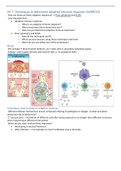Summary
Summary Integrated Biomedical Sciences HC 7 - 12
- Course
- Institution
Very comprehensive summary of these lectures (look at my other documents to get all the lectures) including all informative images. I got graded an 8.9 for this exam :)
[Show more]



